Harmonic Suppressed Wilkinson Power Divider Using Parallel Resonant Shunt Stub
Abstract
1. Introduction
2. Analysis of Parallel Resonant Shunt Stub
3. Design of Harmonic-Suppressed WPD
3.1. A-Type HS WPD Using PRSS
3.2. Harmonic Suppression Filter Using PRSS
3.3. B-Type HS WPD Using Harmonic Suppression Filter
4. Experimental Results
5. Conclusions
Author Contributions
Funding
Institutional Review Board Statement
Informed Consent Statement
Data Availability Statement
Conflicts of Interest
References
- Wilkinson, E.J. An N-Way Hybrid Power Divider. IEEE Trans. Microw. Theory Tech. 1960, 8, 116–118. [Google Scholar] [CrossRef]
- Kim, J.; Jeon, S.; Kim, M.; Urteaga, M.; Jeong, J. H-Band Power Amplifier Integrated Circuits Using 250-nm InP HBT Technology. IEEE Trans. Terahertz Sci. Technol. 2015, 5, 215–222. [Google Scholar] [CrossRef]
- Chieh, J.-C.S.; Yeo, E.; Farkouh, R.; Castro, A.; Kerber, M.; Olsen, R.B.; Merulla, E.J.; Sharma, S.K. Development of Flat Panel Active Phased Array Antennas Using 5G Silicon RFICs at Ku- and Ka-Bands. IEEE Access 2020, 8, 192669–192681. [Google Scholar] [CrossRef]
- Feghhi, R.; Joodaki, M. Odd-Mode Instability Analysis of fT-Doubler Hybrid Power Amplifiers Based on GaN-HEMT. IEEE Trans. Circuits Syst. II Express Briefs 2021, 68, 1193–1197. [Google Scholar]
- Lotfi, S.; Roshani, S.; Roshani, S.; Gilan, M.S. Wilkinson Power Divider with Band-pass Filtering Response and Harmonics Suppression Using Open and Short Stubs. Frequenz 2020, 74, 169–176. [Google Scholar] [CrossRef]
- Li, Y.C.; Xue, Q.; Zhang, X.Y. Single- and Dual-Band Power Dividers Integrated with Bandpass Filters. IEEE Trans. Microw. Theory Tech. 2013, 61, 69–76. [Google Scholar] [CrossRef]
- Deng, P.-H.; Dai, L.-C. Unequal Wilkinson Power Dividers with Favorable Selectivity and High-Isolation Using Coupled-Line Filter Transformers. IEEE Trans. Microw. Theory Tech. 2012, 60, 1520–1529. [Google Scholar] [CrossRef]
- Xu, K.D.; Bai, Y.; Ren, X.; Xue, Q. Broadband Filtering Power Dividers Using Simple Three-Line Coupled Structures. IEEE Trans. Compon. Packag. Manuf. Technol. 2019, 9, 1103–1110. [Google Scholar] [CrossRef]
- Liu, Y.; Sun, S.; Zhu, L. Design of n-Way Wideband Filtering Power Dividers with Good Port–Port Isolation. IEEE Trans. Microw. Theory Tech. 2021, 69, 3298–3306. [Google Scholar] [CrossRef]
- Chen, C.-J.; Ho, Z.-C. Design Equations for a Coupled-Line Type Filtering Power Divider. IEEE Microw. Wirel. Compon. Lett. 2017, 27, 257–259. [Google Scholar] [CrossRef]
- Chen, M.-T.; Tang, C.-W. Design of the Filtering Power Divider with a Wide Passband and Stopband. IEEE Microw. Wirel. Compon. Lett. 2018, 28, 570–572. [Google Scholar] [CrossRef]
- Zhang, G.; Wang, X.; Hong, J.-S.; Yang, J. A High-Performance Dual-Mode Filtering Power Divider with Simple Layout. IEEE Microw. Wirel. Compon. Lett. 2018, 28, 120–122. [Google Scholar] [CrossRef]
- Wang, D.; Guo, X.; Wu, W. Wideband Unequal Power Divider with Enhanced Power Dividing Ratio, Fully Matching Bandwidth, and Filtering Performance. IEEE Trans. Microw. Theory Tech. 2022, 70, 3200–3212. [Google Scholar] [CrossRef]
- Song, K.; Fan, M.; Zhang, F.; Zhu, Y.; Fan, Y. Compact Triple-Band Power Divider Integrated Bandpass-Filtering Response Using Short-Circuited SIRs. IEEE Trans. Compon. Packag. Manuf. Technol. 2017, 7, 1144–1150. [Google Scholar] [CrossRef]
- Lee, B.; Nam, S.; Lee, J. Filtering Power Divider with Reflectionless Response and Wide Isolation at Output Ports. IEEE Trans. Microw. Theory Tech. 2019, 67, 2684–2692. [Google Scholar] [CrossRef]
- Zhang, X.Y.; Wang, K.-X.; Hu, B.-J. Compact Filtering Power Divider with Enhanced Second-Harmonic Suppression. IEEE Microw. Wirel. Compon. Lett. 2013, 23, 483–485. [Google Scholar] [CrossRef]
- Wang, Y.; Zhang, X.-Y.; Liu, F.-X.; Lee, J.-C. A Compact Bandpass Wilkinson Power Divider with Ultra-Wide Band Harmonic Suppression. IEEE Microw. Wirel. Compon. Lett. 2017, 27, 888–890. [Google Scholar] [CrossRef]
- Woo, D.-J.; Lee, T.-K. Suppression of Harmonics in Wilkinson Power Divider Using Dual-Band Rejection by Asymmetric DGS. IEEE Trans. Microw. Theory Tech. 2005, 53, 2139–2144. [Google Scholar]
- Yang, J.; Gu, C.; Wu, W. Design of Novel Compact Coupled Microstrip Power Divider with Harmonic Suppression. IEEE Microw. Wirel. Compon. Lett. 2008, 18, 572–574. [Google Scholar] [CrossRef]
- Kumar, M.; Islam, S.N.; Sen, G.; Kumar Parui, S.; Das, S. Harmonic Suppressed Wilkinson Power Divider with Filtering Characteristic for GSM Application. In Proceedings of the 2018 IEEE MTT-S International Microwave and RF Conference (IMaRC), Kolkata, India, 28–30 November 2018; pp. 1–3. [Google Scholar]
- Lin, C.-M.; Su, H.-H.; Chiu, J.-C.; Wang, Y.-H. Wilkinson Power Divider Using Microstrip EBG Cells for the Suppression of Harmonics. IEEE Microw. Wirel. Compon. Lett. 2007, 17, 700–702. [Google Scholar] [CrossRef]
- Yi, K.-H.; Kang, B. Modified Wilkinson Power Divider for nth Harmonic Suppression. IEEE Microw. Wirel. Compon. Lett. 2003, 13, 178–180. [Google Scholar]
- Jamshidi, M.; Lalbakhsh, A.; Lotfi, S.; Siahkamari, H.; Mohamadzade, B.; Jalilian, J. A neuro-based approach to designing a Wilkinson power divider. Int. J. RF Microw. Comput.-Aided Eng. 2020, 30, e22091. [Google Scholar] [CrossRef]
- Karimi, G.; Menbari, S. A Novel Wilkinson Power Divider Using Lowpass Filter with Harmonics Suppression and High Fractional Bandwidth. Microelectron. J. 2018, 71, 61–69. [Google Scholar] [CrossRef]
- Jedkare, E.; Shama, F.; Sattari, M.A. Compact Wilkinson Power Divider with Multi-Harmonics Suppression. AEU Int. J. Electron. Commun. 2020, 127, 153436. [Google Scholar] [CrossRef]
- Moloudian, G.; Soltani, S.; Bahrami, S.; Buckley, J.L.; O’flynn, B.; Lalbakhsh, A. Design and fabrication of a Wilkinson power divider with harmonic suppression for LTE and GSM applications. Sci. Rep. 2023, 13, 4246. [Google Scholar] [CrossRef] [PubMed]
- Choe, W.; Jeong, J. Compact Modified Wilkinson Power Divider with Physical Output Port Isolation. IEEE Microw. Wirel. Compon. Lett. 2014, 24, 845–847. [Google Scholar] [CrossRef]
- Choe, W.; Jeong, J. N-Way Unequal Wilkinson Power Divider with Physical Output Port Separation. IEEE Microw. Wirel. Compon. Lett. 2016, 26, 243–245. [Google Scholar] [CrossRef]
- Chang, T.-J.; Huang, T.-J.; Hsu, H.-T. A New Design of Wilkinson Power Divider Using Radial Stubs Featuring Size Reduction and Bandwidth Enhancement with Physical Isolation. In Proceedings of the 2017 IEEE 18th Wireless and Microwave Technology Conference (WAMICON), Cocoa Beach, FL, USA, 24–25 April 2017; pp. 1–4. [Google Scholar]
- Cheng, K.-K.M.; Ip, W.-C. A Novel Power Divider Design with Enhanced Spurious Suppression and Simple Structure. IEEE Trans. Microw. Theory Tech. 2010, 58, 3903–3908. [Google Scholar] [CrossRef]
- Trantanella, C.J. A Novel Power Divider with Enhanced Physical and Electrical Port Isolation. In Proceedings of the 2010 IEEE MTT-S International Microwave Symposium, Anaheim, CA, USA, 23–28 May 2010; p. 1. [Google Scholar]
- Wang, X.; Sakagami, I.; Mase, A.; Ichimura, M. Wilkinson Power Divider with Complex Isolation Component and Its Miniaturization. IEEE Trans. Microw. Theory Tech. 2014, 62, 422–430. [Google Scholar] [CrossRef]
- Horst, S.; Bairavasubramanian, R.; Tentzeris, M.M.; Papapolymerou, J. Modified Wilkinson Power Dividers for Millimeter-Wave Integrated Circuits. IEEE Trans. Microw. Theory Tech. 2007, 55, 2439–2446. [Google Scholar] [CrossRef]
- Antsos, D.; Crist, R.; Sukamto, L. A Novel Wilkinson Power Divider with Predictable Performance at K and Ka-band. In Proceedings of the 1994 IEEE MTT-S International Microwave Symposium Digest, San Diego, CA, USA, 23–27 May 1994; Volume 2, pp. 907–910. [Google Scholar]
- Jang, Y.; Jeong, J. Modified Wilkinson Power Divider with Resonating Stubs for Physical Isolation of Output Ports. In Proceedings of the 2022 19th International SoC Design Conference (ISOCC), Gangneung-si, Republic of Korea, 19–22 October 2022; pp. 380–381. [Google Scholar]
- Pozar, D.M. Microwave Engineering; Wiley: Hoboken, NJ, USA, 2009. [Google Scholar]
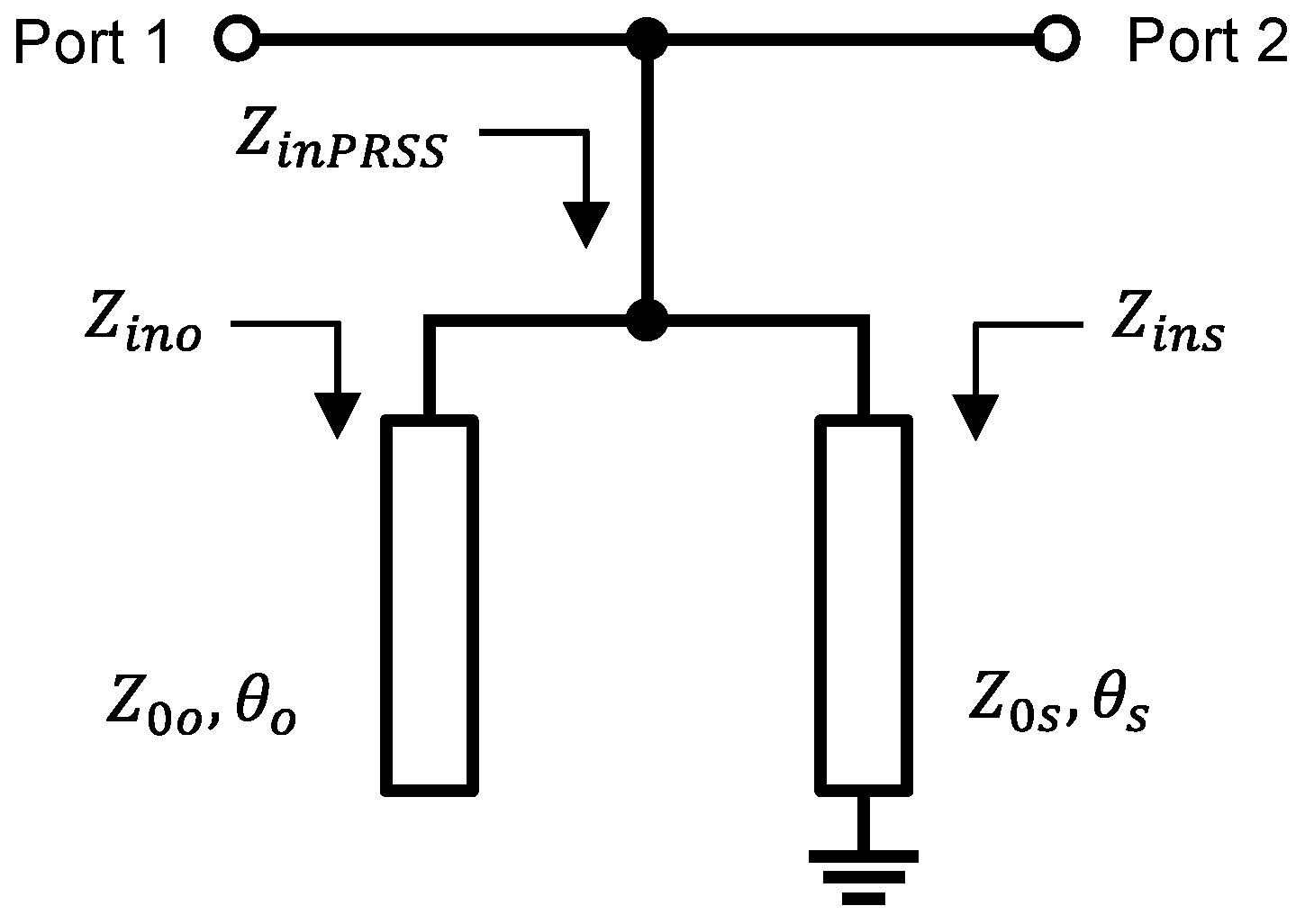
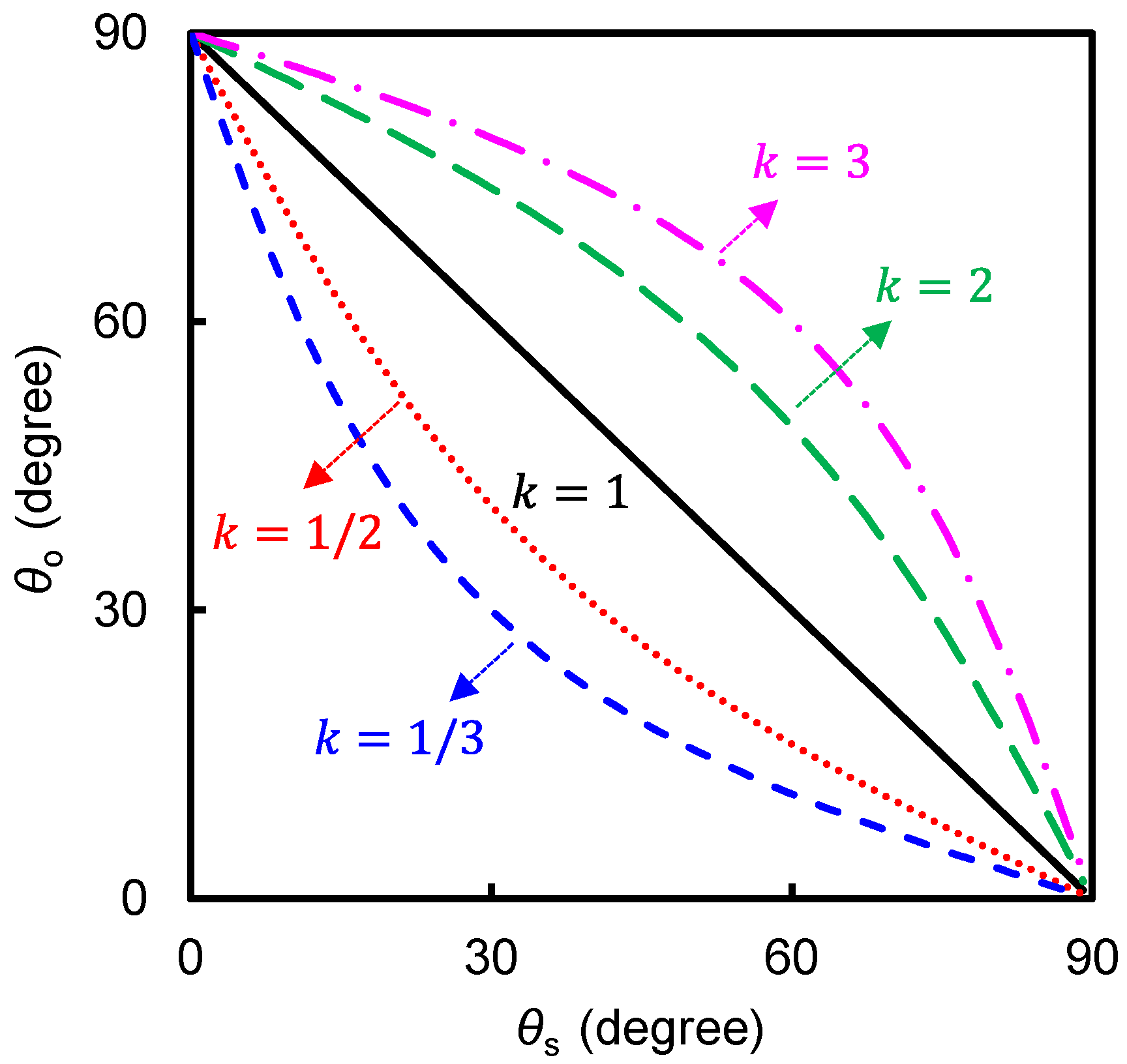
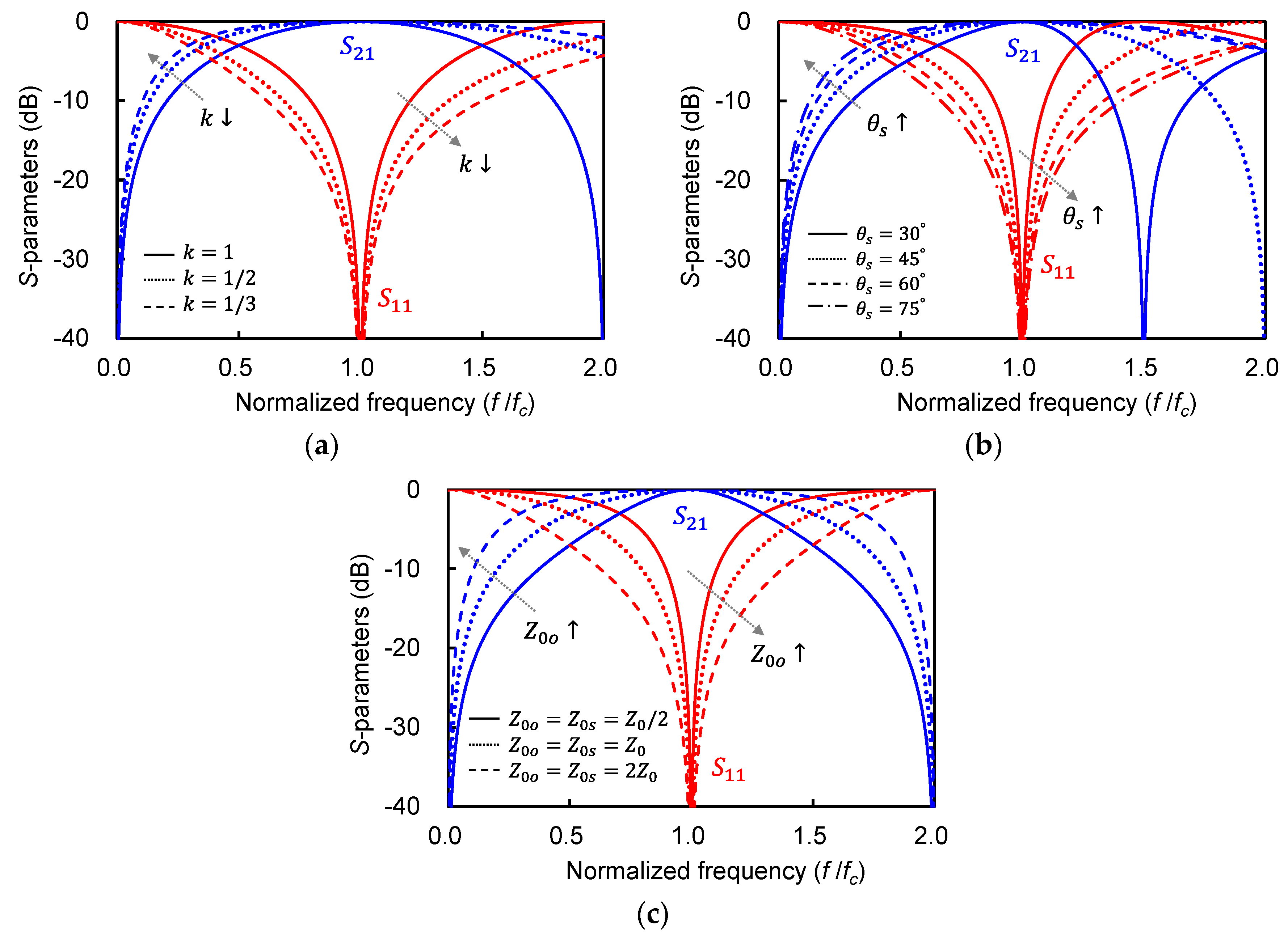
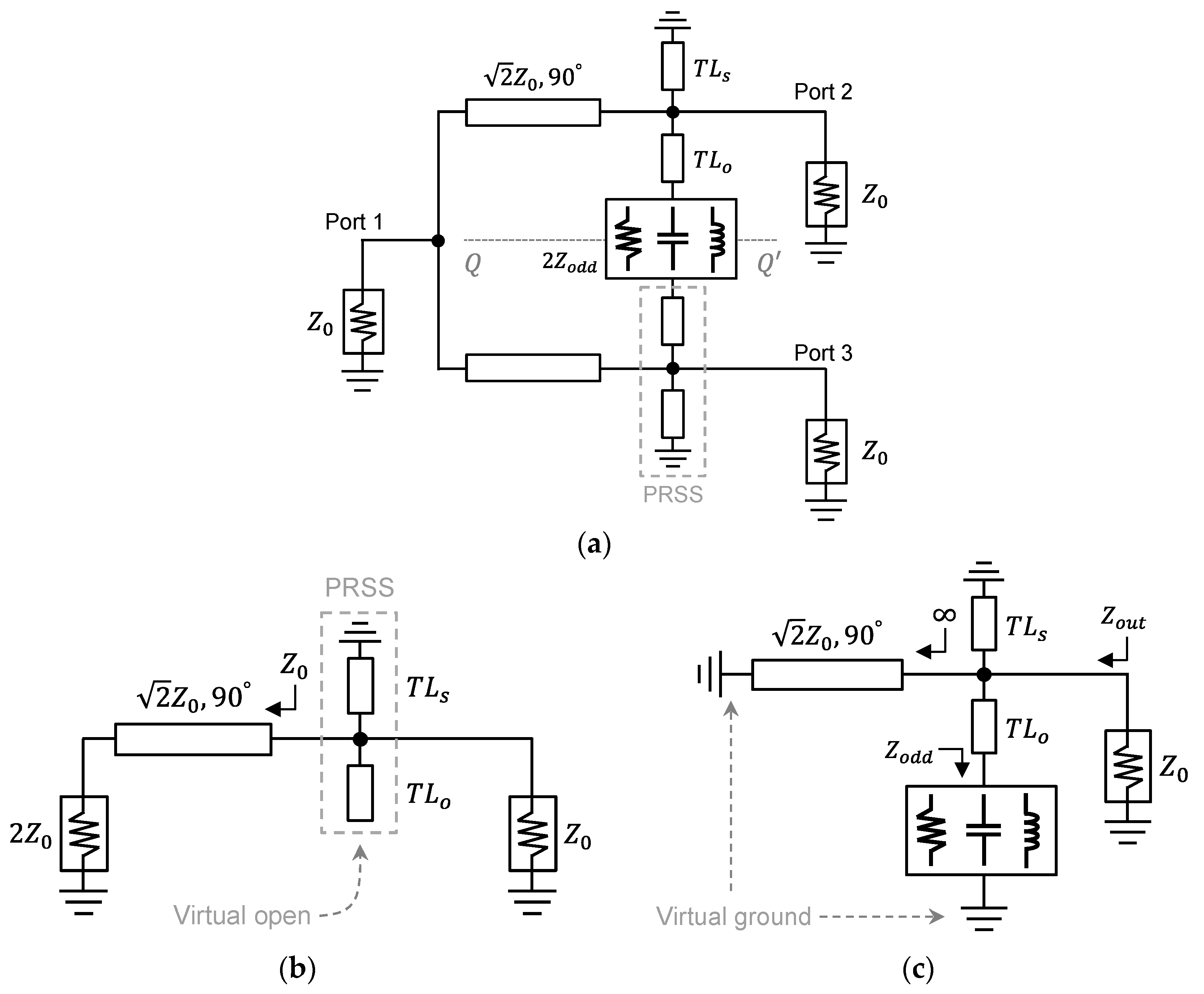

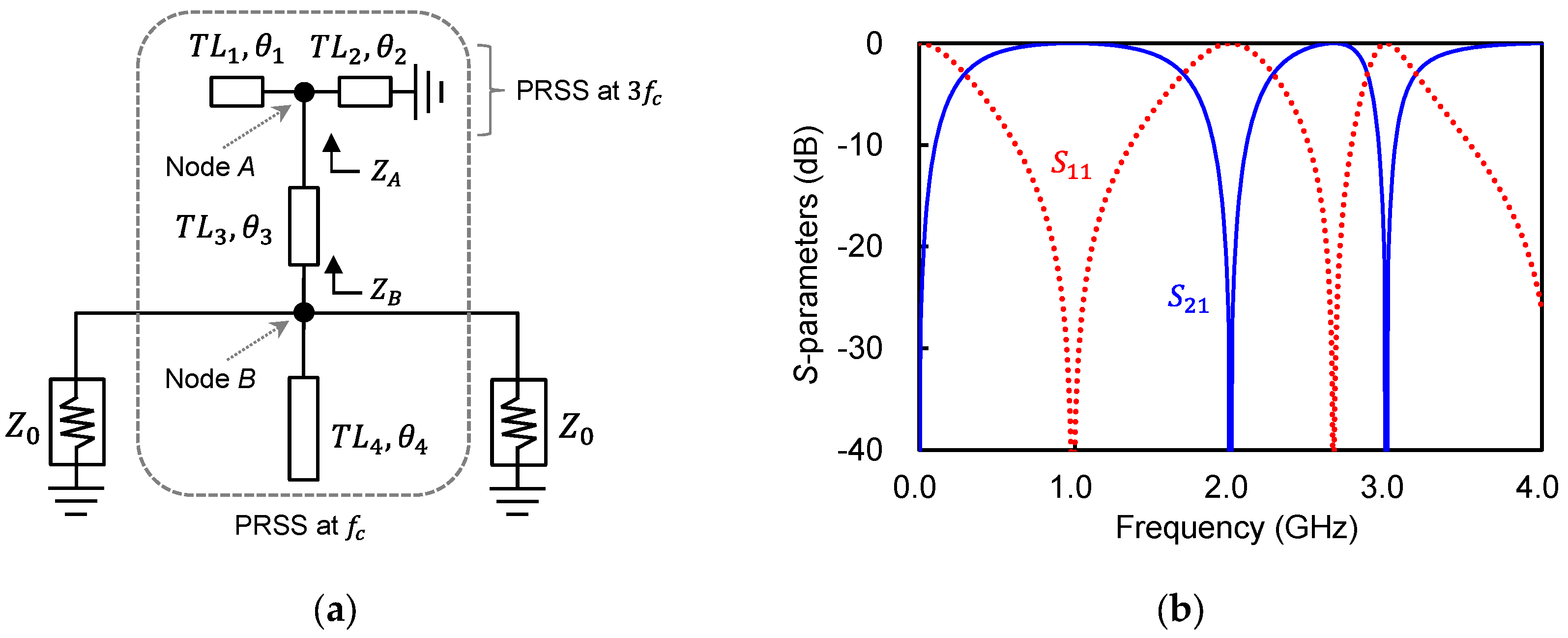


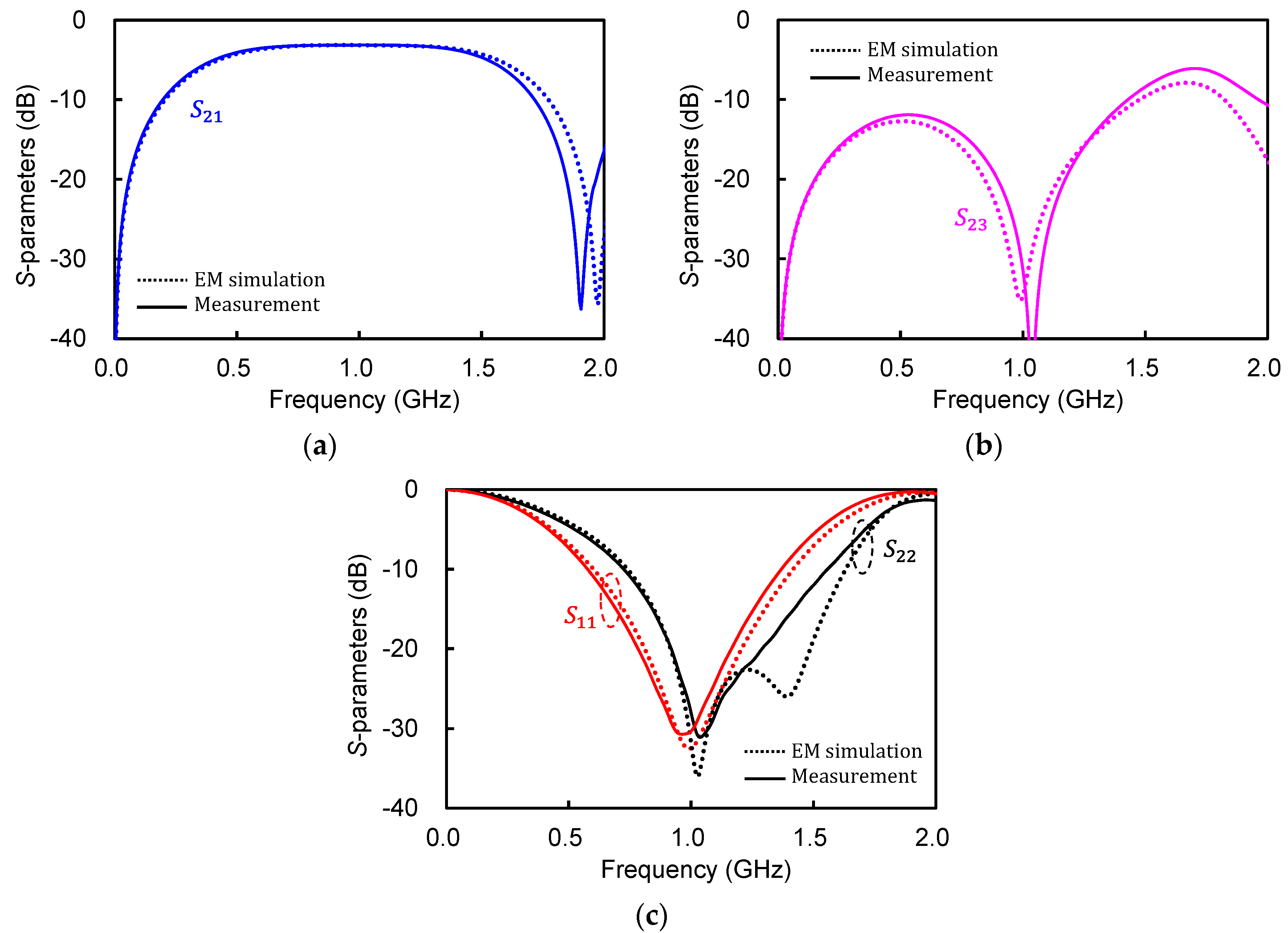

| k = 1 | k = 1/2 | k = 1/3 | |
|---|---|---|---|
| θs = θo (degree) | 45 | 35.3 | 30 |
| fc (GHz) | Topology | Circuit Size (λg × λg) | FBW * (%) | S-Parameters at fc (dB) | Harmonic Suppression | dc Suppression | Physical Separation | |||||
|---|---|---|---|---|---|---|---|---|---|---|---|---|
| |S11| | |S22| | |S21| | |S32| | 2nd | 3rd | |||||||
| [8] | 2.42 | Three-line coupled structure | 0.016 | 82.6 | >12 | 3.8 | >23 | N/A | O | O | ||
| [10] | 1 | Coupled line | 0.061 | 30 | 24 | 20 | 3.8 | 35 | **~35 | N/A | O | × |
| [11] | 2.02 | Modified parallel-coupled line | 0.051 | 57.1 | >15 | N/A | >22.5 | >40 | O | O | ||
| [15] | 1 | short-circuited microstrip stub resonators | N/A | 15 | ~33 | ~30 | 4.3 | ~35 | N/A | O | O | |
| [19] | 0.9 | Defected ground structure | 0.005 | N/A | >30 | 3.15 | 23 | <10 | >35 | × | × | |
| [21] | 2.4 | Electromagnetic bandgap cell | N/A | N/A | 23 | 31 | 3.4 | 25 | <10 | 32.5 | × | × |
| [23] | 2.55 | Low pass filter | N/A | N/A | 28 | 27 | 3.02 | 46.5 | 20.6 | 20.1 | × | O |
| [24] | 0.935 | Semicircular resonator | 0.05 | *** 36 | 20.9 | 22 | 3.05 | 18 | <10 | ~16 | × | × |
| This work | 1 | Parallel resonant shunt stub | 0.049 | 130 | 30.3 | 28.1 | 3.2 | 31.4 | 16 | N/A | O | O |
| 1 | Parallel resonant shunt stub | 0.048 | 129 | 27.9 | 24.6 | 3.2 | 29.2 | 21 | 25.8 | O | O | |
Disclaimer/Publisher’s Note: The statements, opinions and data contained in all publications are solely those of the individual author(s) and contributor(s) and not of MDPI and/or the editor(s). MDPI and/or the editor(s) disclaim responsibility for any injury to people or property resulting from any ideas, methods, instructions or products referred to in the content. |
© 2024 by the authors. Licensee MDPI, Basel, Switzerland. This article is an open access article distributed under the terms and conditions of the Creative Commons Attribution (CC BY) license (https://creativecommons.org/licenses/by/4.0/).
Share and Cite
Jang, Y.; Jeong, J. Harmonic Suppressed Wilkinson Power Divider Using Parallel Resonant Shunt Stub. Electronics 2024, 13, 424. https://doi.org/10.3390/electronics13020424
Jang Y, Jeong J. Harmonic Suppressed Wilkinson Power Divider Using Parallel Resonant Shunt Stub. Electronics. 2024; 13(2):424. https://doi.org/10.3390/electronics13020424
Chicago/Turabian StyleJang, Yeongmin, and Jinho Jeong. 2024. "Harmonic Suppressed Wilkinson Power Divider Using Parallel Resonant Shunt Stub" Electronics 13, no. 2: 424. https://doi.org/10.3390/electronics13020424
APA StyleJang, Y., & Jeong, J. (2024). Harmonic Suppressed Wilkinson Power Divider Using Parallel Resonant Shunt Stub. Electronics, 13(2), 424. https://doi.org/10.3390/electronics13020424






